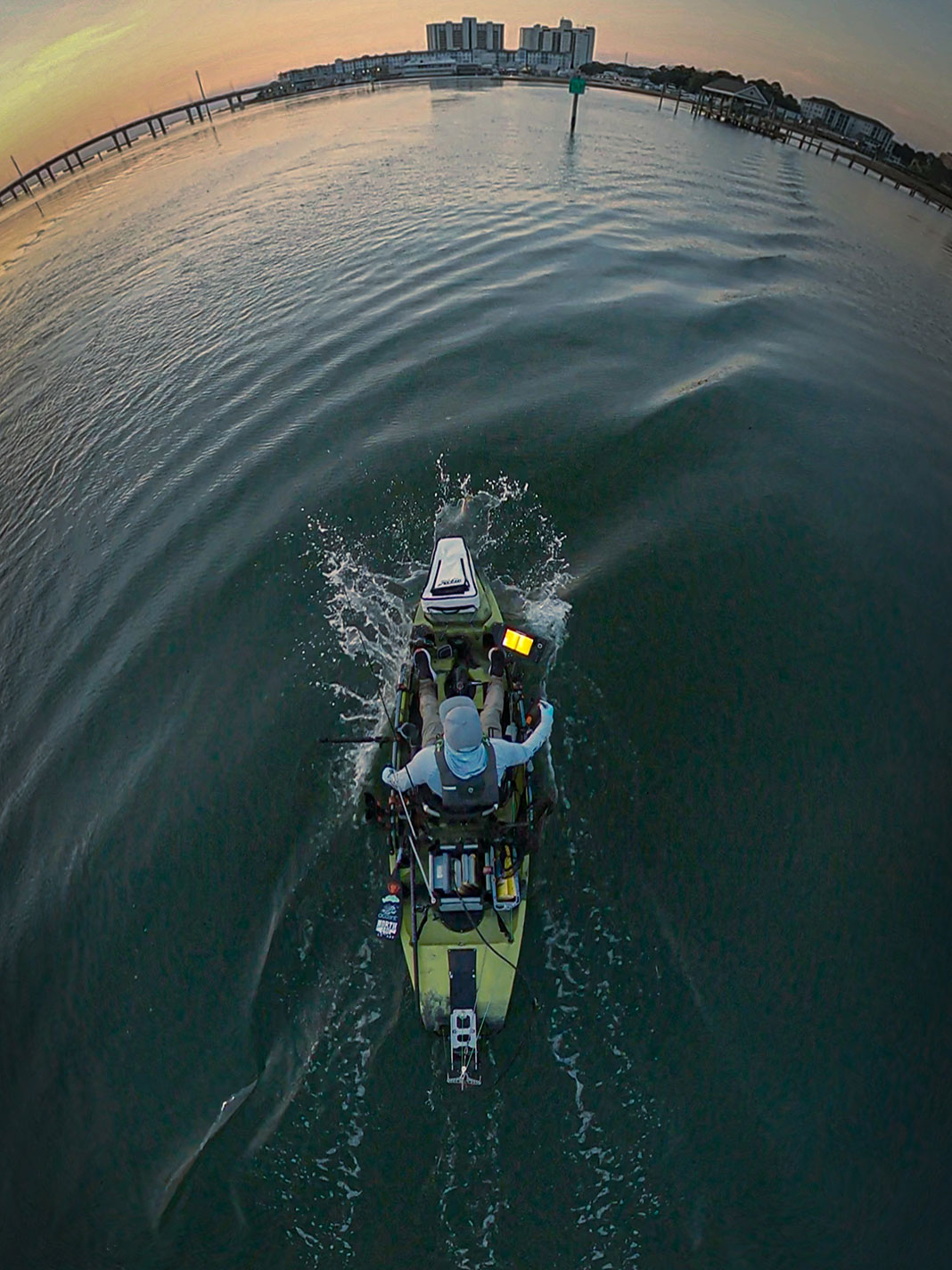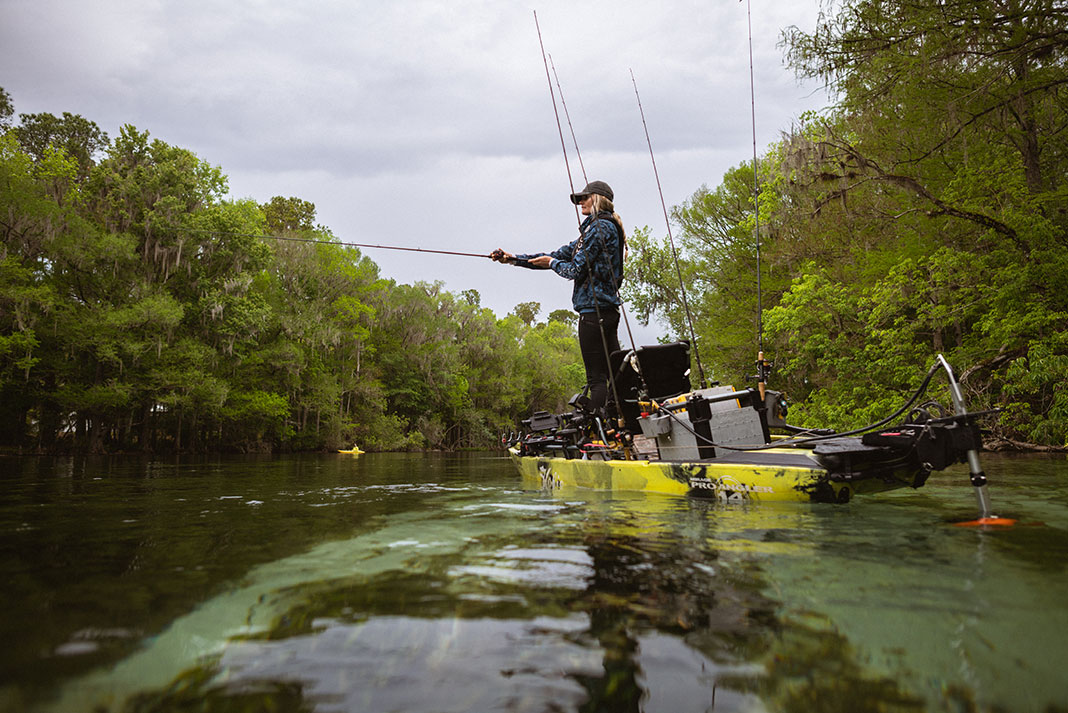Products You May Like
Up until 1846, doctors anesthetized patients with morphine and whiskey. Before the 14th century, people marked time with the sun. After the invention of the steam engine, people were finally able to travel faster than 20 miles per hour. Someday in the future, we will consider the time before brushless motors with the same reverence as the greatest advancements in history.
Brushless electric motors have only been around since the 1960s, but they are already common in cordless power tools, washing machines and Tesla sedans. Now, brushless motors are popular for motorizing a fishing kayak. With everyone rushing out to power their fishing kayak, we figured it is a good time to take a close look at brushless kayak motors.
Why You Should Try a Brushless Kayak Motor
What is a Brushless Kayak Motor?
One of the first applications for brushless motors was powering small watercraft. Since 2005, German manufacturer Torqeedo has focused on producing brushless electric outboard boat motors. In the last decade, they have turned their expertise toward designing and rigging electric motors for kayak fishing.
Director of Service and Quality Sven Kirchhoff explains how a brushless motor works. “In a nutshell, to make an electric motor rotate you have a magnetic field produced by a set of magnets on one side and you have a set of coils which produces a magnetic field through current flow.” The interaction of the two magnetic fields forces the motor to turn a shaft connected to a propeller.
In a brushed motor, electricity flows into the magnetic field through a graphite brush on the stator and rotor. As the rotor turns, the electric current cuts on and off to create the magnetic field. Over time, the brushes wear out and reduce power.
In a brushless motor, power to the electromagnet is achieved electronically instead of with the physical contact of the brush. Kirchhoff explains, “A microprocessor controls energizing and de-energizing specific coils.”
Most trolling motors use brushed motors. Electric outboards, like those made by Torqeedo, use brushless motors.
The advantage is a lighter, more efficient and durable electric motor. The disadvantage? Brushless motors are more expensive than a comparable brushed motor. Installing an electric outboard on a fishing kayak can be a little more complicated than installing a trolling motor, too.
How to Install a Brushless Kayak Motor
No one has installed more electric outboards on more boats than Torqeedo Sales Manager Jeff Little. “I have added electric motors to dozens of makes and models of kayaks, even inflatables,” he says.
Little points out electrical rigging is more difficult than physically installing the motor and steering system. “If you’re using a third-party battery, you have to use a waterproof battery case,” he points out. Exposing a 12-volt battery to water could result in shock or fire.
To prevent damage to the battery, Torqeedo’s system includes an IP67 waterproof 30 amp-hour lithium-ion battery. “The lithium-ion battery only weighs eight pounds, compared to a 40-pound 12-volt lead-acid battery,” Little says.
The lithium-ion battery is also more efficient with a longer lifespan and better recharge rate. The Torqeedo battery takes full advantage of the remote throttle’s power level and range display.
The power cable runs directly from the motor to the battery with a waterproof connection on each end. Little suggests placing the battery close to the center of the kayak where it will best balance the weight of the angler and the motor.
Installing the motor on the kayak and running the steering controls takes an afternoon of shade tree engineering. Little says each boat is a little different. Some are easier than others. Ideally, he recommends looking into how easy installation is before purchasing the kayak.
The Torqeedo steering system is designed to tie into the kayak’s existing rudder controls. Or, if the boat doesn’t have access to rig cables below deck, Torqeedo offers an above-deck option.
Many kayaks are pre-rigged with a flat area and inserts in the stern designed to accept the Torqeedo motor mount. A quick search on Google results in dozens of adapter plates, throttle mounts and steering systems to fit the Torqeedo to any kayak. Little also offers instructional videos on his YouTube channel, The Little Stuff. “I haven’t met a kayak I couldn’t install a motor [on],” Little jokes.

Is a Brushless Motor Worth the Money?
The basic Torqeedo kit, including battery, base, steering system and motor costs more than many fishing kayaks. Add greater range and more power, and the price exceeds the cost of two kayaks. At the other end of the range, a simple tiller-controlled trolling motor and 12-volt marine battery are available for a few hundred dollars.
Tournament pro and Torqeedo team member, Jody Queen, used to power his kayak with a modified trolling motor and 12-volt battery. “The trolling motor offered advantages over paddling,” he admits. However, the weight of the trolling motor and battery were a serious drag. Then, Queen started noticing a reduction in performance.
“I fish 250 to 280 days a year, so I’m hard on an electric motor,” he says. After a year, his trolling motor’s top speed dropped from 4.8 miles per hour to 3.5. “I found it difficult to motor into the wind and current,” he adds.
This loss of performance is attributed to the brushed motor’s design. “The brushes wear out,” Queen says. This reduces power to the motor and, in turn, decreases speed and torque. “Fixing the motor would require taking it to a technician.”
After he killed his trolling motor, Queen moved to a Torqeedo 403 AC electric outboard. “I started with a top speed of 5.2 miles per hour and a year later, the top speed is still 5.2 miles per hour,” he says.
Not only is the motor mechanism more durable, but the matching lithium battery has a longer lifespan. “Over time, charging a 12-volt battery reduces its capacity,” he points out. On the other hand, a lithium-ion battery can be recharged hundreds of times with an insignificant effect on its power.
Queen uses his electric outboard to motor to the fishing grounds and zoom between locations. An electric outboard isn’t as maneuverable as a trolling motor, but it’s faster and more powerful.
So, if you’re a weekend angler who uses his kayak a few times a month, you can get away with a less expensive and simpler trolling motor. But, if you need extended range, higher speeds and greater durability, then a brushless outboard motor is the only way to go.
More time and less energy, brushless motors offer fast, easy fishing. | Feature photo: Courtesy Torqeedo

